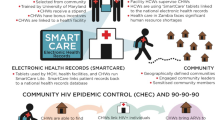Objectives: This paper describes and compares three innovative methods for preventing perinatal HIV transmission. Each of these strategies has been developed based on an in-depth assessment of the strengths and weaknesses of existing prevention approaches, and the needs of the populations they serve. Methods: Florida expanded an existing outreach program to include women in jails in several high-prevalence counties. Incarcerated women were offered testing for pregnancy and HIV and linked to medical and supportive services. One Connecticut hospital sought to increase prenatal HIV testing rates by requiring HIV test results in the electronic medical records. This program is being expanded to other hospitals throughout the state. Louisiana has implemented a systematic review of perinatal data in order to identify potential programmatic enhancements. This review has led to the perinatal fast track system, designed to quickly identify HIV-infected pregnant women and connect them to care. Results: Each program demonstrated improvements in indicators related to prevention of perinatal HIV transmission, such as increased utilization of prenatal care, increased prenatal testing rates, and decreases in perinatal HIV transmission. Conclusions: These case studies emphasize two key similarities among these programs: the value of collaboration between agencies providing care and services to HIV-infected and high-risk women of childbearing age, and the importance of maximizing opportunities for HIV testing and treatment. These strategies have demonstrated effectiveness in improving health outcomes and reducing perinatal HIV transmission.
Similar content being viewed by others
Notes
All statistical comparisons were performed using the Pearson chi-square test.
EPS data represent a subset of cases reported in HARS. Data collection associated with EPS is considerably more labor-intensive, and not all cases in the HARS data can be located for complete EPS follow up. However, EPS generally contains more reliable prenatal care detail.
Adequacy of prenatal care is measured by using the Kessner index, which combines information on the length of gestation, timing of the first prenatal care visit, and number of visits.
REFERENCES
Cooper ER, Charurat M, Mofenson L, Hanson IC, Pitt J, Diaz C, Hayani K, Handelsman E, Smeriglio V, Hoff R, Blatner W, and the Women Infants' Transmission Study Group. Combination antiretroviral strategies for the treatment of pregnant HIV-1-infected women and prevention of perinatal HIV-1 transmission. J Acq Immune Def Syndr 2002;29:484–94.
Connor EM, Sperling RS, Gelber R, Kiselev P, Scott G, O'Sullivan MJ, VanDyke R, Bey M, Shearer W, Jacobson, RL, Jimenez E, O'Neill E, Bazin B, Delfraissy J-F, Culnane M, Coombs R, Elkins M, Moye J, Stratton P, Balsley J, for the Pediatric AIDS Clinical Trials Group Protocol 076 Study Group. Reduction of maternal-infant transmission of human immunodeficiency virus type 1 with zidovudine treatment. N Engl J Med 1994;331:1173–80.
Centers for Disease Control and Prevention. HIV/AIDS Surveillance Report. Atlanta: US Department of Health and Human Services, Centers for Disease Control and Prevention; 1994;6(2):10. Available at: http://www.cdc.gov/hiv/stats/ hivsur62.pdf. Accessed February 11, 2005.
Centers for Disease Control and Prevention. HIV/AIDS Surveillance Report, 2003. Atlanta: US Department of Health and Human Services, Centers for Disease Control and Prevention; 2004;15:13. Available at: http://www.cdc.gov/hiv/ stats/2003SurveillanceReport.pdf. Accessed February 11, 2005.
Centers for Disease Control and Prevention. Enhanced perinatal HIV/AIDS surveillance—United States, 1999–2001. Atlanta: US Department of Health and Human Services, Centers for Disease Control and Prevention; 2004:1–22. Special Surveillance Report 4. Available at: http://www.cdc.gov/hiv/ stats/SpecialReport10-7.pdf.Accessed January 19, 2005.
Royce RA, Walter EB, Fernandez MI, Wilson TE, Ickovics JR, Simonds RJ, for the Perinatal Guidelines Evaluation Project. Barriers to universal prenatal HIV testing in four U.S. locations in 1997. Am J Public Health 2001;91:727– 33.
Schrag SJ, Arnold KE, Mohle-Boetani JC, Lynfield R, Zell ER, Stefonek K, Noga H, Craig AS, Sanza LT, Smith G, Schuchat A, for the Active Bacterial Core surveillance team. Prenatal screening for infectious diseases and opportunities for prevention. Obs Gynecol 2003;102:753– 60.
Centers for Disease Control and Prevention. HIV testing among pregnant women—United States and Canada, 1998–2001. MMWR 2002;51:1013–6.
State of Florida Department of Health, Public Health Statistics Section. Florida vital statistics annual report, 2002. August, 2003. Available at: http://www.doh.state.fl.us/planning_eval/ vital_statistics/02Vitals/2002VSCOMP.pdf. Accessed September 13, 2004.
US Department of Justice, National Institute of Corrections. Correctional health care: guidelines for the management of an adequate delivery system. Washington, DC: National Institute of Corrections; 2001. Available at: http://www.nicic.org/ pubs/2001/chc-files/fulldocument.pdf. Accessed January 19, 2005.
Institute of Medicine, Committee on Perinatal Transmission of HIV and Commission on Behavioural and Social Sciences and Education. Reducing the odds: preventing perinatal transmission of HIV in the United States. Washington, DC: National Academy Press; 1999. Available at: http://www.nap.edu/books/0309062861/html/index.html. Accessed January 19, 2005.
US Department of Health and Human Services, Office of Inspector General. Reducing obstetrician barriers to offering HIV testing. Washington, DC: Department of Health and Human Services; March 2002. Report No. OEI-05-01-00260. Available at: http://oig.hhs.gov/oei/reports/oei-05-01-00260.pdf. Accessed January 19, 2005.
Centers for Disease Control and Prevention. Revised recommendations for HIV screening of pregnant women. MMWR 2001;50(RR-19):59–86.
ACKNOWLEDGMENTS
The authors would like to thank Jeffrey Wiener, Divisions of HIV/AIDS Prevention, CDS, for assistance with statistical tests.
Author information
Authors and Affiliations
Corresponding author
Rights and permissions
About this article
Cite this article
Clark, J., Sansom, S., Simpson, B.J. et al. Promising Strategies for Preventing Perinatal HIV Transmission: Model Programs from Three States. Matern Child Health J 10, 367–373 (2006). https://doi.org/10.1007/s10995-005-0047-x
Received:
Accepted:
Published:
Issue Date:
DOI: https://doi.org/10.1007/s10995-005-0047-x




